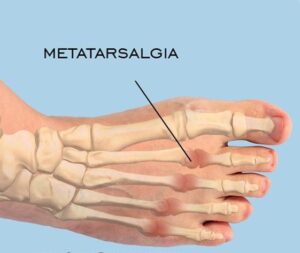Metatarsalgia – Causes and Treatment Options
March 10 2023
Do you have a pain in the ball of your foot? Perhaps you are experiencing metatarsalgia. Dr. Mustafa discusses common symptoms, cause, and treatment options.
Overview:
- What is metatarsalgia?
- Symptoms
- Causes
- Treatment
- Prevention
What is Metatarsalgia?
Metatarsalgia is an overuse condition in which the ball of the foot becomes painful and inflamed. It is a broad term used to describe pain or discomfort in the forefoot.
One of the most common causes of this pain in the ball of the foot is uneven pressure loading due to foot alignment issues. The metatarsal bones in the forefoot and their surrounding structures can be overloaded with hypermobile, flat feet or excessively high arched feet. Other factors such as ill-fitting footwear, arthritis, bursitis fractures, nerve problems, and high impact activities (running and jumping) can also alter the forces exerted on the foot causing metatarsalgia pain in the forefoot.
What are the Symptoms?
The primary symptom of metatarsalgia is pain at the distal end of metatarsal bone/s (the ball of the foot). The term metatarsalgia is often used as a broad term with forefoot pain as other forefoot conditions can also present with similar symptoms.
Symptoms can include:
- Aching and burning in the forefoot or at the ball of the foot. This can increase during exercise and remain after activity.
- Pain that increases with exercise or flexion of the toes and is particularly worse with flexible shoes or barefoot.
- Sharp or shooting pain through the forefoot and into the toes.
What are the possible causes?
There are a number of factors that can cause chronic pain, excessive pressure and load through the forefoot. Often the pressure develops over a prolonged period of time. Possible causes may include:
- High impact sport or exercise
- Ill fitting footwear (i.e. high-heeled shoes)
- High arched foot (pes cavus) with prominent metatarsal head bones
- Altered length and/or size of metatarsals or bones in feet.
- Clawing, mallet or hammer toes
- Tight calves and/or Achilles tendon
- Altered biomechanics that can cause uneven forefoot pressure distribution
- Changes in bone structure (i.e. arthritis)
- Changes in soft tissue (plantar plate tears, bursitis, Morton’s neuroma, synovitis)
- Fat pad reduction which commonly occurs with aging
- Stress fracture in long bones of the foot (Freiberg’s)
What are treatment options?
When it comes to treatment for metatarsalgia, the diagnosis is extremely important in the success of any treatment program. A specific diagnosis means treatment can be far more specific in addressing the cause which lead to more successful outcomes. Various foot problems can cause symptoms in the forefoot resembling metatarsalgia.
Imaging is a great way to help diagnoses forefoot complaints. A referral for an x-ray and ultrasound can be arranged by your podiatrists if needed. The goal of treatment and rehabilitation is to restore normal range of motion, strength and function of the foot.
Initial treatment will usually involve a number strategies to reduce pain and prevent recurrence.
Metatarsalgia exercises involving stretching and strengthening to reduce and alter pressure and load in the forefoot.
Manual therapy and mobilization is often utilized and recommended by your podiatrist.
Various forms of strapping or taping. This can help with pain reduction and improved function.
Footwear modifications or changes can reduce pressure and relieve tightness in the forefoot.
Extracorporeal shock wave therapy where bursitis or chronic inflammation is evident in the forefoot.
Custom made orthotics can be used to reduce damaging forces and redistribute pressure in the forefoot. Various orthotic modifications can be employed to improve function and reduce chronic metatarsalgia pain. Metatarsal pads, metatarsal domes, 1st ray cutouts of varying lengths, 5th ray cutouts and U-pads are all possible modifications which may be needed for specific foot types.
An experienced podiatrist will know just what metatarsalgia treatment is needed following a thorough gait analysis and examination.
Metatarsalgia recovery time will vary depending on the diagnosis, but normally gradual improvement commences in line with the appropriate treatment.
If these management options prove insufficient, metatarsalgia surgery may be considered, however, this is rarely required, and all conservative treatment options should be exhausted before surgery is discussed.
How is Metatarsalgia Prevented?
The role of a podiatrist is to maintain healthy feet, not just provide a short-term fix for problematic feet. It is important to have feet, legs, footwear and orthotic appliances reviewed regularly by your podiatrist to ensure more serious problems are avoided and prevented. Early detection of gait abnormalities, poor foot posture, poor circulation and neurological conditions can go a long way towards ensuring your feet last a lifetime.
A gait analysis is part of a thorough bio-mechanical assessment and helps to assess normal mobility and function. A bio-mechanical examination helps to ensure normal mobility and function is maintained.
Having your footwear fitted correctly is also important in preventing metatarsalgia foot complaints. Ill fitting footwear is a significant contributor to foot problems and ankle pain. Shoes should always be tested in person before purchase to ensure they are comfortable.
Preventing re-injury or further injury means eliminating abnormal loading or pressure. It is vital to change any damaging load and reduce harmful forces causing the forefoot pain. This is where orthotics can be extremely useful. They are important in improving the function and alignment of the foot. Orthotics are designed by your podiatrist following specific measurements completed during a bio-mechanical assessment.
 Left untreated, metatarsalgia can lead to a further increase in pain but can also develop into a chronic condition. Other parts of the body will often compensate due to a change in walking from limping in an attempt to offload the painful forefoot. Pain can then commence in these overloaded structures as a result making the problem even more complex.
Left untreated, metatarsalgia can lead to a further increase in pain but can also develop into a chronic condition. Other parts of the body will often compensate due to a change in walking from limping in an attempt to offload the painful forefoot. Pain can then commence in these overloaded structures as a result making the problem even more complex.
Referred or new pain can occur in the opposite uninjured foot, or even worse, in the hip or back. Early diagnosis and specific treatment can help to avoid these problems.
Are you experiencing PAD symptoms? You can contact Dr. Mustafa’s office at (239) 430-3668 (FOOT) or visit www.NaplesPodiatrist.com to schedule an examination.
—————–



 Fax: (239) 692-9436
Fax: (239) 692-9436 Tel: 239-430-3668
Tel: 239-430-3668
